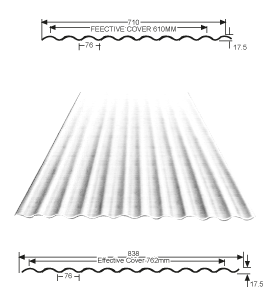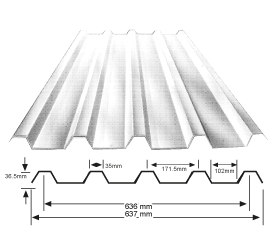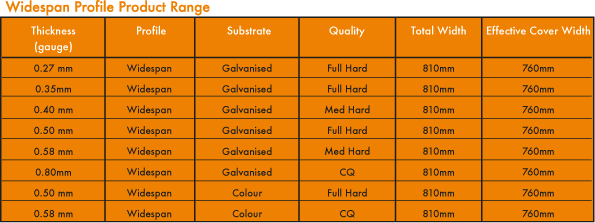Profiled Sheets
Our roofing systems protect thousands of homes, commercial and industrial buildings. Achieving a good looking product is not sufficient in competitive global markets. It is attention to detail in the manufacturing process that has earned our roofing systems an international reputation for excellence.
Roofing Materials
There are three profiles commonly used in the roofing industry. These profiles can be supplied in galvanised and colour coated material which has a wide range of colour options available. We provide an analysis of the three most popular products together with the relevant technical data. The standard ranges are indicated. Non-standard sizes and special inquiries are welcome and can be forwarded to our sales staff.
Corrugated Profile
The corrugated profile is the oldest and most widely used profile in the roofing industry. This is due to it’s ease of handling and fixing, relative strength, cost effectiveness and it’s successful use in designs depicting the old Victorian era style. Corrugated sheeting can furthermore be factory cranked and bull nosed to a wide range of radii to suit specific requirements.When using corrugated sheeting, the recommended minimum roof pitch or slope in excess of 15 meters is 10 degrees and for slopes less than 15 meters is 7.5 degrees. `The corrugated profile is manufactured in two distinct profiles, namely the 8.5 corrugated and the wider 10.5 corrugated. The numerical reference indicates the number of corrugations in the sheet.


IBR Type Profile
The IBR type profile is today the most popular profile used in the construction industry. The abbreviation “IBR” stands for inverted box rib. The bold angular appearance of this profile makes it a very attractive choice, but more importantly it has many advantageous characteristics i.e. it’s strength to weight ratio is designed to provide the most optimum loadspan consistancy, the deep and broad flutes of the IBR profile ensures excellent drainage capacity. As a result it is widely used in numerous sections of the building industry.
The IBR profile can furthermore be factory cranked , curved and bullnosed to a wide range of radii to suit specific requirement. A “stiffening” rib can also be ordered in the broad flute of the profile specifically to help with the aesthetical appearance with the removal of oil canning from the broad flute. When using the IBR profile the minimum recommended roof pitch is 5 degrees for roof slopes less than 30 meters, and 7.5 degrees for roof slopes in excess of 30 meters. The technical analyses of the IBR profile is as follows:
Widespan Profile
The Widespan profile is a roofing and cladding profile designed to provide the building industry with an economical alternative to the deeper box rib IBR profile without sacrificing the popular fluted concept so frequently used in the modern architecture. The shallower widespan profile has a better coverwidth, thus achieving savings in labor and erection costs.
As a result it is widely used in numerous markets. The Widespan profile can furthermore be factory cranked, curved and bullnosed to a widerange of radii to suit specific requirements. A “stiffening” rib can also be ordered in the flute of the profile specifically to help with the aesthetical appearance with the removal of oil canning from the broad flute. The technical analyses of the Widespan profile is as follows:








